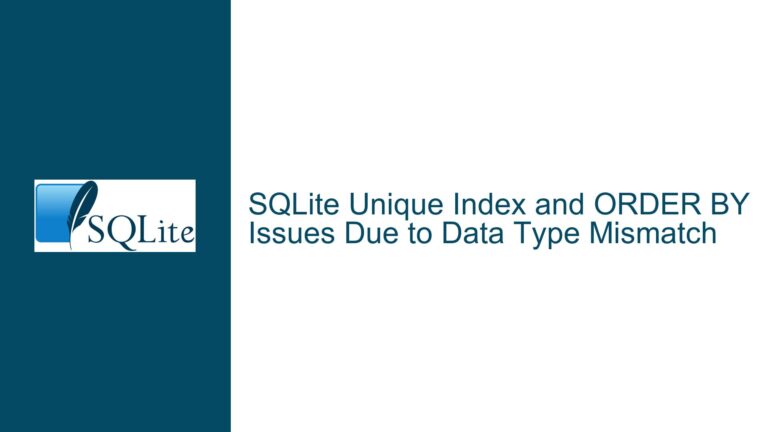Optimizing SQLite Range Queries for Events Spanning Multiple Days
Understanding the Challenge of Range Queries with Multi-Day Events
When working with SQLite to query events that span multiple days, particularly when trying to find events that occur within a specific date range, the database’s indexing behavior can present unique challenges. The core issue revolves around efficiently querying a table where events have both a start date (datetime) and an end date (datetime_end). The goal is to retrieve all events that overlap with a given date range, even if the event started before the range or ends after it.
The table schema in question is straightforward:
CREATE TABLE events(
id INTEGER PRIMARY KEY,
type TEXT,
datetime TEXT,
datetime_end TEXT
) STRICT;
An index is created on the datetime and datetime_end columns:
CREATE INDEX idx_dt ON events(datetime, datetime_end);
The query aims to find all events that overlap with January 2020:
SELECT * FROM events
WHERE datetime < '2020-02-01'
AND datetime_end > '2020-01-01';
However, the query plan reveals that SQLite is not fully utilizing the index for both columns:
QUERY PLAN
`--SEARCH events USING INDEX idx_dt (datetime<?)
This indicates that SQLite is only using the datetime column from the index, leading to suboptimal performance, especially with large datasets.
Why SQLite Struggles with Multi-Column Range Queries
The root cause of the performance issue lies in how SQLite handles multi-column indexes and range queries. SQLite’s indexing mechanism is based on B-trees, which are highly efficient for single-column range queries but less so for multi-column range queries involving inequalities on both columns.
When a query includes a range condition on the first column of a multi-column index (datetime < '2020-02-01'), SQLite can efficiently narrow down the search using the index. However, the second column (datetime_end > '2020-01-01') cannot be used to further narrow the search because the index is sorted first by datetime and then by datetime_end. As a result, SQLite must scan all rows that satisfy the first condition and then filter them based on the second condition. This leads to a full or partial index scan, which is significantly slower than a direct index lookup.
Additionally, the order of columns in the index matters. If the index were created as (datetime_end, datetime), SQLite might use it differently, but the fundamental limitation remains: range queries on multiple columns are inherently less efficient due to the way B-tree indexes work.
Strategies for Optimizing Range Queries on Multi-Day Events
To address the performance issues, several strategies can be employed, each with its own trade-offs. These strategies include rethinking the index structure, leveraging subqueries, and using compound queries to minimize the number of rows scanned.
1. Reversing the Index Column Order
One approach is to create an index with the columns reversed:
CREATE INDEX idx_dt_reversed ON events(datetime_end, datetime);
This allows SQLite to use the index for the datetime_end condition, potentially reducing the number of rows scanned. However, this approach is not a silver bullet, as the query still requires a scan of the index to find rows that satisfy both conditions.
2. Using Separate Indexes and Combining Results
Another strategy is to create separate indexes for datetime and datetime_end and then combine the results using a UNION or UNION ALL operation:
CREATE INDEX idx_datetime ON events(datetime);
CREATE INDEX idx_datetime_end ON events(datetime_end);
WITH x AS (
SELECT * FROM events
WHERE datetime > '2020-01-01' AND datetime < '2025-02-01'
UNION ALL
SELECT * FROM events
WHERE datetime_end > '2020-01-01' AND datetime_end < '2025-02-01'
)
SELECT DISTINCT * FROM x;
This approach can be faster because each subquery can leverage its respective index efficiently. However, it introduces additional complexity and may require post-processing to remove duplicates.
3. Leveraging Subqueries to Narrow the Search
If the dataset has a known structure, such as events being contiguous with no gaps, a subquery can be used to find the start of the relevant range and then query the events within that range:
SELECT * FROM events
WHERE datetime < '2020-02-01'
AND datetime > (SELECT datetime FROM events
WHERE datetime < '2020-01-01'
ORDER BY datetime DESC LIMIT 1);
This approach minimizes the number of rows scanned by first identifying the boundary of the relevant range and then querying within that boundary.
4. Combining Indexes with Additional Filters
If the query includes additional filters, such as type and event, composite indexes can be created to further optimize performance:
CREATE INDEX idx_type_event_datetime ON events(type, event, datetime);
CREATE INDEX idx_type_event_datetime_end ON events(type, event, datetime_end);
These indexes allow SQLite to efficiently filter by type and event before applying the range conditions on datetime and datetime_end.
5. Using Temporary Tables for Complex Queries
For extremely large datasets or complex queries, it may be beneficial to use temporary tables to store intermediate results. This can reduce the computational overhead of repeatedly scanning large portions of the index:
CREATE TEMP TABLE temp_events AS
SELECT * FROM events
WHERE datetime < '2020-02-01'
AND datetime_end > '2020-01-01';
SELECT * FROM temp_events;
This approach is particularly useful when the same range query is executed multiple times, as the temporary table can be reused.
Conclusion
Optimizing range queries for events spanning multiple days in SQLite requires a deep understanding of how indexes work and the limitations of B-tree structures. By carefully designing indexes, leveraging subqueries, and combining results from multiple queries, it is possible to achieve significant performance improvements. However, each approach comes with trade-offs, and the optimal solution depends on the specific characteristics of the dataset and the query patterns. Experimentation and profiling are essential to determine the most effective strategy for a given use case.






